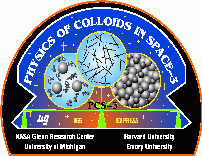People involved:
-
Emory/Montpellier collaboration:
- Eric R. Weeks -- Principle Investigator (Emory University)
- Luca Cipelletti -- Co-Investigator (Université Montpellier 2)
- Gianguido Cianci (Emory)
- Rachel Courtland (Emory)
- Christina Wallace (Emory)
Other PCS-3 Principle Investigators:
- David A. Weitz (Harvard)
- Michael J. Solomon (University of Michigan)
